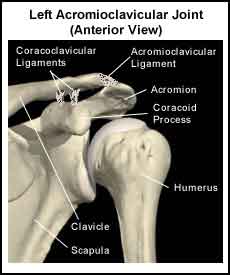To understand the role that the acromioclavicular joint plays in the shoulder complex, you may want to also review basic shoulder anatomy.

The shoulder complex is made up of three bones, which are connected by muscles, ligaments, and tendons. The large bone in the upper arm is called the humerus. The shoulder blade is called the scapula and the collarbone is called the clavicle.
The acromioclavicular joint of the shoulder complex is where the outer (lateral) part of the clavicle is joined to a projection on the top of the scapula known as the acromion process. The joint connecting these two bones is known as the acromioclavicular (AC) joint. The AC joint allows a small amount of movement to occur between clavicle and the acromion process.
Ligaments are like strong ropes that help connect bones and provide stability to joints. In the AC joint there are three main ligaments. The acromioclavicular ligament connects the acromion process and the clavicle. The coracoclavicular ligaments (the trapezoid ligament and conoid ligament) connect the clavicle with another projection of the scapula called the corocoid process.
